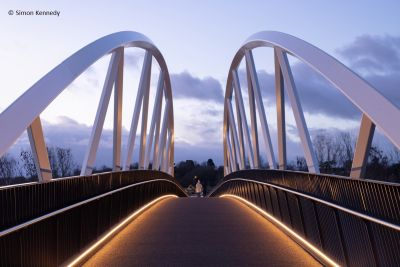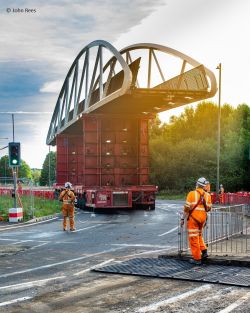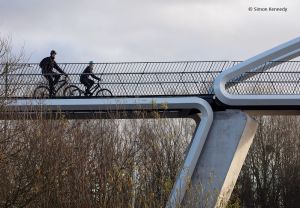Hams Way Footbridge
Structural Steel Design Awards 2021 - Award
Hams Way Footbridge is a new pedestrian and cycle bridge forming part of the strategically important Worcester Southern Link Road Phase 4 project. It replaces a signal-controlled pedestrian crossing across the A4440, one of Worcester’s busiest roads, and improves National Cycle Network route 46 by separating cyclists and pedestrians from traffic at the busy Powick Roundabout.
The site has several important features which were addressed in the design. The area is prone to regular flooding, being located close to the confluence of the Rivers Teme and Severn, and is archaeologically sensitive as it was the location of the Battle of Worcester in 1651. The site is also bordered by a number of historically important pieces of infrastructure and the A4440 is a high load route, requiring a 6.45m clearance under the footbridge, which lengthens the 1:20 gradient approach ramps.
The focal point of the bridge is the elegant trussed-arch main span, supported on dramatic leaning concrete piers to achieve the client’s aspiration for a recognisable ‘gateway’ structure with a lightweight ‘floating’ aesthetic, while being sensitive to its surroundings, given the historic nature of the area.
The client expressed a preference for an arch-type main span for consistency with other footbridges in the region. Aware that ‘traditional’ steel arch bridges with vertical hangers can fall foul of the Eurocode pedestrian dynamics requirements, the design team proposed a 42m-long bowstring truss. The truss diagonals provide additional stiffness and push the resonant frequencies above the limits for pedestrian excitation. The 6m-high trusses lean inward by 7.5 degrees and are unbraced to give a dramatic user experience when crossing on foot.
The main span chords and diagonal members are formed from square hollow sections (SHS) rotated through 45 degrees. These diagonal sections are designed to catch light on their upper half with shadow cast on the lower, a visual effect which makes them appear pleasingly slender.
The deck plate is 10mm-thick and is stiffened with flat plate stiffeners welded beneath, and two edge stiffeners above, formed by folding up the edges of the deck plate. Cross-beams are rolled universal beam sections at 3m centres, designed with stiffened connections to the truss chords to provide a degree of ‘U-frame’ stiffness, stabilising the unbraced top chord.
At the ends of the arches the top and bottom chords meet at a tight curve, hiding the supports and giving the impression that the bridge is floating above the piers. This element of the bridge is fabricated from conically-curved steel plate, stiffened internally. Early collaboration between the design and fabrication teams was key in achieving a detail that is efficient in both structural performance and fabrication effort. The finished product is seamless, giving no hint of the complicated engineering within.
The main span is reached via multi-span approach ramps, where economy and speed of construction were the main design drivers while matching the architectural success of the main span, as well as a staircase to the north. A modular approach was adopted using standardised 12m-long steel spans on single rectangular hollow section steel piers. The ramp edge beams feature the same rotated SHS form as the main span chords, but use simplified flat plate cross-beams for economy. The ramp edge beams mirror the tightly curved arch end segments at the junction between the ramps and the main span.
The steel piers were required to be relatively flexible in the longitudinal direction to accommodate thermal expansion in flexure, but stiff enough in the transverse direction to provide stiffness and restraint to eccentric loading. Pedestrian dynamics were carefully considered and achieving sufficient stiffness to avoid lateral vibration was found to be the governing design criteria for the rectangular hollow section (RHS) steel columns.
The whole main span exceeded road transportation limits and it was delivered to site in three pieces. An assembly ‘jig’ was constructed close to the main span’s final position and the transport segments were site-welded together to complete the superstructure. To minimise disruption, the main span was installed using a self-propelled modular transporter during a two-hour closure of the A4440 on a Saturday morning prior to the peak traffic period.
The approach ramps were fabricated and transported in two-span sections with end-plate preloaded bolted connections. Access to tighten the edge beam bolts is from a hidden access hatch on the inner-lower face of the diamond edge beam, hiding any discontinuity the panels would have on the appearance of the edge beam.
Hams Way Footbridge is an excellent example of how an ordinary road span can be upgraded to a ‘statement’ bridge with a few carefully considered architectural enhancements. Complex steelwork detailing was delivered in a clear and buildable way through collaboration across the design and construction teams. Digital tools were utilised to effectively communicate design intent with the construction team as well as to the client and many stakeholders of the bridge.
| Architect | Moxon Architects |
| Structural Engineer | COWI |
| Steelwork Contractor | S H Structures Ltd |
| Main Contractor | Alun Griffiths (Contractors) Ltd |
| Client | Worcestershire County Council |
Judges' comment
An excellent example of how inspired architectural details can create a ‘statement’ bridge. Simply rotating the square cords through 45 degrees has produced a dramatic shadow line. This, coupled with clever detailing at the supports, gives a pleasing slender floating expression to the bridge. Installation of the main span in just two hours minimised disruption to the busy junction below.






